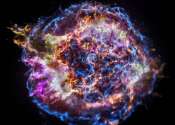Astronomers map interstellar dust grains in Milky Way
Between the stars in our Milky Way, vast amounts of tiny dust grains are floating aimlessly around. They form the building blocks of new stars and planets. But we still don't know what elements exactly are available to form ...









